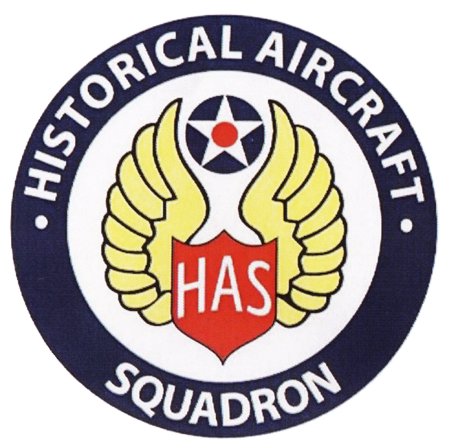A Visit and Personal Reflection of the Historical Aircraft Squadron
by Charlie Kukla, America 250-Ohio Communications Intern and Aspiring Writer
Like birds on a wire
Sitting peacefully at rest
Each one has soared higher
And in history, they crest.
-Charlie Kukla

What is the Historical Aircraft Squadron?
In Lancaster, Ohio there is a museum established by a group of historical aviation enthusiasts to spread their love of aviation.
The Historical Aircraft Squadron is non-profit, free to the public and entirely volunteer-led.
It is part of America 250-Ohio’s Ohio Air & Space Trail program, and we’re proud to have it as a destination, representing yet another stop in showcasing our state’s long history with aviation. The Air & Space Trail is dedicated to providing visitors and residents with an easy-to-follow guide to locations showing Ohio’s storied history of aviation and aerospace.
A large part of the museum’s focus is on education, supporting the community and providing unforgettable experiences through the events they participate in. Their primary mission is to preserve, restore, display and operate military aircraft.
Maintenance varies based on the plane and whether it is owned by the museum or a private owner. It generally involves the mechanic evaluating the issue and taking necessary steps to fix it. As for a full restoration that includes flight worthiness, the process is more complicated. It requires verifying paperwork, purchasing insurance and checking parts to ensure a safe and legal flight.
While the museum focuses on curating military planes, it isn’t limited to just aviation, which is why there are so many other military-related historical items. Among their diverse collection, artifacts on display also include a 1942 Plymouth used as a military staff car in World War II; military and firefighter uniforms; a helicopter; a glider; model planes; and various military and aviation memorabilia like log books, machine gun ammunition and a portrait cutout of Marilyn Monroe, along with a picture of her working in a factory during World War II.
The artifacts aren’t limited to the military, with civilian, homebuilt aircraft included as well. The museum’s inventory includes many donations that have helped result in its diverse collection.
Inside the Museum
While walking through the museum, we could hear the other guests as they were taken through the exhibits like us. Being able to see others learn about the museum at the same time as me was a reminder of the educational importance it provides to the community, making sure everyone learns the history and stories of these planes.
I experienced a feeling of nostalgia as I took in the sight of soaring planes all around, suspended in air above me. The vintage style stirred memories of visiting countless museums as a child, many of which were based on collecting the history of aviation and the military.
It felt special to be in the presence of such large machines that once tore through the sky, yet now hang peacefully like birds on a wire. Wandering through a museum always brings a feeling of being lost in time, with artifacts of the past all around that each carry their own story.
When I walked through museum exhibits as a child, I was always in awe of the dinosaurs hulking over me. I’d always wonder what each one’s life was like, and what stories they would tell if they could.
While birds are technically the dinosaurs of the sky, I believe these planes are better suited for the title, once dominating the clouds with their massive, impressive machinery, feats of engineering that go to show how far humanity has come. After all, many of these planes were crafted just decades after the Wright Brothers first brought powered flight to humankind. Yet now, like the dinosaurs of old, the planes sit on display, having long since retired from their rule.
Just like those dinosaurs I was enamored with as a child, as I walked through the Historical Aircraft Squadron, I similarly wondered what stories each of these planes could tell, and what history each holds. Thankfully, there’s much more known about the history of the planes than there is about the bones of dinosaurs, so now it’s just a matter of telling their stories.
Among the countless unforgettable stories told, there was one plane’s story in particular that stuck out to me the most.
A Story of the Sky
In December 1971, as part of the Indian Air Force, the Folland Gnat soared through the skies to liberate East Pakistan, now known as Bangladesh, during the Indo-Pakistani war of 1971.
One of these Folland Gnats is on display in the Historical Aircraft Squadron museum, and is the only plane there to have seen combat. While each plane has a unique history and story, this one stands out for its service and is a must-see if you come to the museum yourself. The original pilot’s helmet and flight suit are on display as well.
It’s not just the stories of the planes that are impactful, either. Visitors often bring their own aviation tales to share with the staff, connecting visitors and volunteers alike through their shared passion.
Community Outreach and Engagement
Aside from their tours, visitors can expect to look forward to many events that the museum hosts and participates in each year.
Once a month on the first Saturday of most of the summer months, along with the local EAA chapter, the museum hosts Young Eagles Day, giving free flights to youths ages 8-18 and engaging them in construction projects where they directly help in the restoration of aircraft.
The museum is always looking to make an unforgettable experience for kids by giving them a taste of aviation. For example, they have had kids participate in the building of model airplanes, and have even shown them first-hand how to use tools and create parts of the plane, giving them direct roles in the assembly and restoration process.
This goes to show the educational impact the museum can have on youth. It was especially meaningful for a set of triplets who volunteered there every Saturday for several years, and to show their appreciation, held their graduation party at the museum. These educational experiences get youth directly involved in restoring historical planes, allowing the museum’s older members to pass their passion along to the next generation.
This is just one way that the museum demonstrates community support. For example, they have also given flights to members of the Wounded Warrior Project.
The museum often does fly-ins in the area, having participated in the Columbus Air Show at Rickenbacker International Airport for the past 2 years.
While it’s unfortunately already passed this year, there’s an especially exciting fall event that you can look forward to next year. Every fall for about the past 20 years, the museum hosts a big band, USO style dance during OSU’s football bi-week, where students come dressed in 1940’s fashion and the soundtrack is set to swing. The event includes a string orchestra, costs $25 per person and is hosted in the hangar. It’s a BYO event, though appetizers, soda and water are provided. The next one is expected to be held in either September or October 2025.
In addition to these annual events, the Historical Aircraft Squadron has made itself an asset to the community in even more ways, with the museum frequently hosting meetings for various organizations, such as a ceremony for a recruiting group from Rickenbacker. Aspiring pilots can even take the test to receive their pilot’s license at the museum.
These events are how knowledge of the museum spreads, with much of it being through word-of-mouth. Some who return may have gotten their pilot’s license there, attended prom there or another reason besides viewing a plane, but when they return, they’re connected through the memory the museum left that had them coming back.
If you would like to become involved, you’re welcome to join as a volunteer. There are volunteers in their teens and those serving in their 90’s. Staff include pilots, mechanics, veterans and aviation enthusiasts, so don’t feel like you’re too young, old or inexperienced in aviation if it’s your passion. Regardless of their differences, the staff and volunteers are connected through their love for aviation.
The museum is open every Wednesday and Saturday in the morning. Other times may vary, so be sure to check their website for the most up-to-date hours.
To learn more about the Ohio Air & Space Trail and find more destinations across it, visit the Trails & Tales program page on our website.

Charles “Charlie” Kukla served as a Fall 2024 Communications Intern for America 250-Ohio. He wrote several blogs as well as served on numerous behind-the-scenes projects and events. Charlie is a recent graduate from The Ohio State University and resides in Columbus, Ohio.